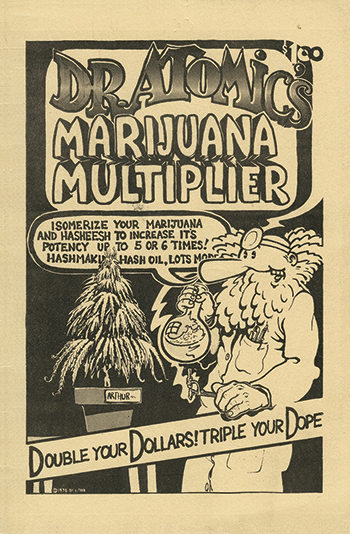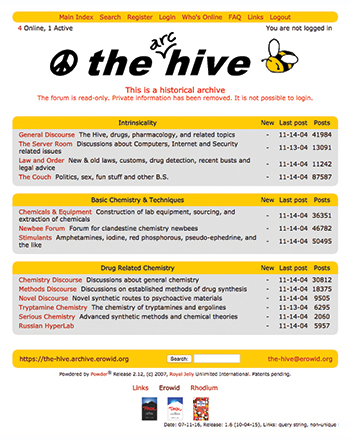Box, Paper, Scanner - Archives at Erowid
Aug 2016
Originally published in Erowid Extracts #29
Citation: Erowid. "Box, Paper, Scanner - Archives at Erowid". Erowid Extracts. Aug 2016;29:16-17. Online edition: Erowid.org/general/about/about_article18.shtml

|

|

|

|

|
Books
Even before Erowid had a name, we were collecting books, papers, and geeky ephemera about psychoactive plants and drugs. In 1998, we had 150 related books. In 2000, Erowid's first benefactor, Bob Wallace, thinned out his personal library and gifted us with twenty boxes of books and periodicals. He had decided, among other changes, to retire his collection of prurient anti-drug, pulp scare-ographies, resulting in the addition of Reefer Madness–style fiction and nonfiction to the Erowid Library. Our physical library has since grown to more than 1,500 titles.Digital Collections
In 1999, we took over the Hyperreal Drug Archives, a curated and lightly-edited collection of more than 1,700 documents. In addition to merging it into Erowid's main online library, it was the first large collection we kept archived as a historical snapshot. In the early 2000s, we added several other collections, some of which came to us digitally, others in print.As colleagues retired from or stopped maintaining their web presence, they asked us to archive their web content for posterity. These included "Diary of a Psychonaut", "The Sonoran Desert Toad" collection, Rhodium's Chemistry and Pharmacology archive, and a snapshot of PoppySeedTea.com, a site created by the mother of a young man who died in 1986 from drinking poppy seed tea.
Physical Collections
The first physical collection we digitized was the 4,000-document Albert Hofmann Collection, which we scanned and databased with funding from Bob Wallace. This collection includes a surprisingly complete array of research documents about LSD and other psychedelics from the 1950s through the 1970s, most previously unavailable online. The physical collection was returned to Switzerland after rebinding and the digital version archived publicly on Erowid.We first visited Sasha and Ann Shulgin at the Shulgin Farm in 1999. Their enticing library included lab and pharmacology notebooks that formed the basis for their books PiHKAL and TiHKAL. At the time, they felt there were still too many privacy issues to make the materials public. Sasha allowed friends to peek through these notebooks but not to scan or photograph them. Then, in 2006, the Shulgins agreed to let them be scanned by trusted assistants and the Shulgin Collection at Erowid was established. Erowid volunteers took on the laborious job of transcribing hundreds of pages of difficult-to-read chemistry-related texts. The work by Team Shulgin and Erowid to document Sasha and Ann's work continues. Erowid Extracts #28 (February 2016) was dedicated to this project.
In 2009, Myron and Jean Stolaroff offered Erowid their collection of somewhat moldy boxes full of documents related to psychedelic psychotherapy to digitize and archive online. In 2014, we completed cataloging the 5,000 items in the Stolaroff Collection and, as of July 2016, we're halfway through the process of writing short abstracts for each. We're excited about the added utility that these abstracts will provide to what could otherwise be a daunting set of personal communications and published articles. The tidied physical papers may now be heading to Stanford University for long-term storage.
Recently, well-known author Michael Pollan, who is working on a book touching on 1960s psychedelic history, asked us if the Stolaroff Collection contained any original documents related to Al Hubbard, an important figure in 20th-century psychedelic history. Our search for "Hubbard" in the collection pulled up 185 related documents, most of which we provided to Pollan to aid his research.
The Hive
It may be less obvious how historical snapshots of defunct websites fit into the big picture, but they are an important part of the Erowid library. They are generally more recent, and more easily mined than stacks of yellowing paper, but just as valuable for the evolution of knowledge and the historical record.In 2015, we were approached by drug geeks who had a complete archive of the long-defunct and controversial website, "the Hive". The Hive was an influential web forum discussing the chemistry of mind-altering compounds. Its frank, explicit discussions of synthesis and extraction made it one of the most infamous psychoactive-related websites of its era, attracting US national television attention. The forum was started in 1997 and by the time it went offline in 2004 (due to hosting issues), it had developed an international community of more than 8,500 active users and half a million posts. Erowid launched the first complete snapshot of the Hive in September 2015, after removal of private information such as passwords, email addresses, and private messages.
Boxes of Stuff
Perhaps the least known archiving work we do is processing small one-or-two-box collections of drug-related books, papers, and "stuff" contributed by individuals. Whether it's a former publisher or author, the family of a deceased enthusiast, or a drug geek cleaning out their closet, lots of people want to see their invested time and money be useful to others.Contributions of books related to psychoactives are incorporated in several ways. If the book isn't already in our slowly growing library, we catalog and add it. Duplicates are offered as educational thank-you gifts to book-collecting donors, helping them build their own libraries.
The ephemera stuck in the corners of donated boxes is often as interesting as the books: advertising from conferences, product packaging, drug containers, festival fliers, pins, stickers, etc. Curious artifacts can enliven otherwise dry collections of materials, documenting the vibrant culture and subcultures that surround psychoactive drugs. Erowid is part of a long lineage of people working to further the field of psychoactive drug-related knowledge. As contributors to this wisdom tradition, we preserve and evolve information about mind-altering substances, practices, and technologies.
Image Credits #


